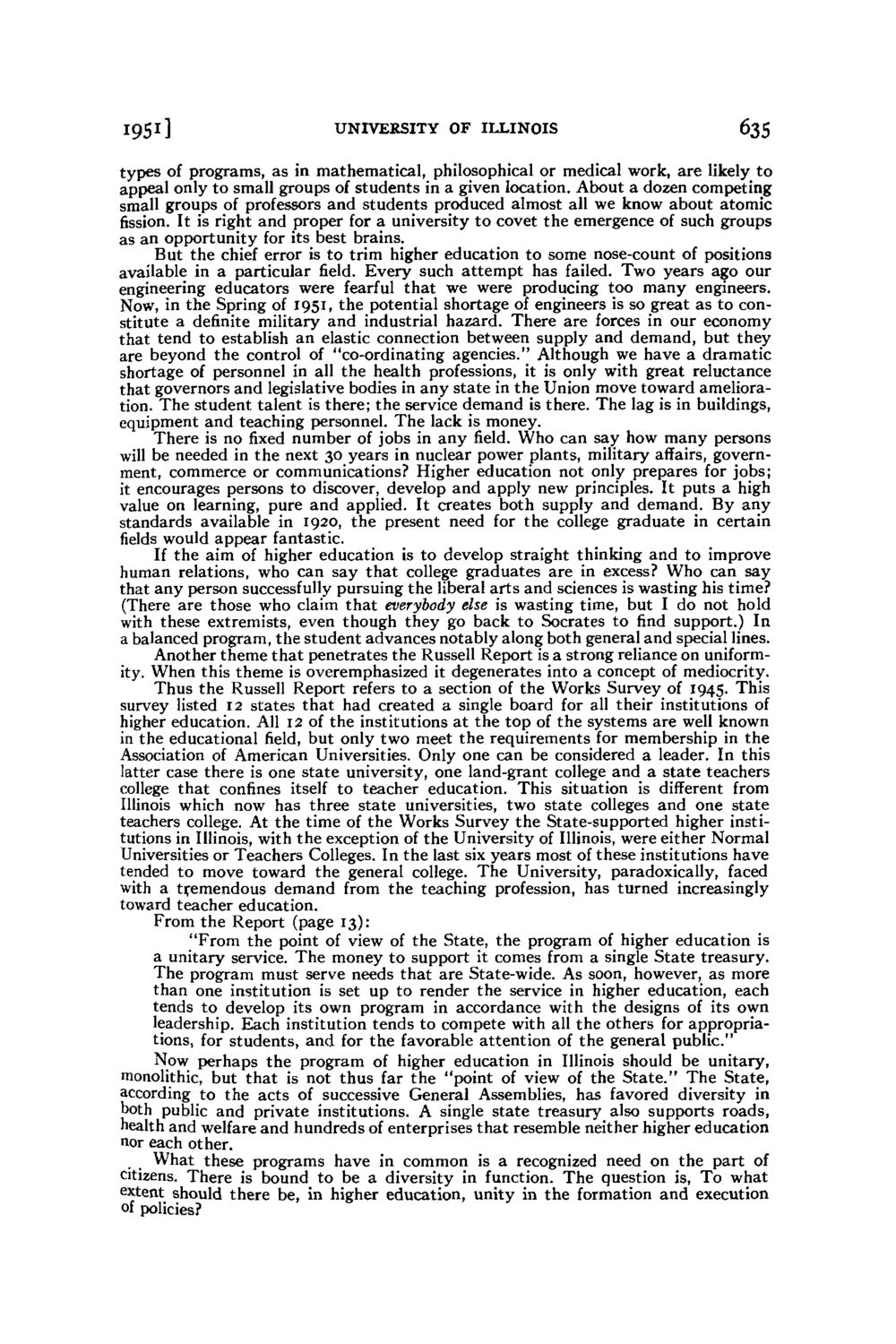| |
| |
Caption: Board of Trustees Minutes - 1952
This is a reduced-resolution page image for fast online browsing.

EXTRACTED TEXT FROM PAGE:
i95i] UNIVERSITY OF ILLINOIS 635 types of programs, as in mathematical, philosophical or medical work, are likely to appeal only to small groups of students in a given location. About a dozen competing small groups of professors and students produced almost all we know about atomic fission. It is right and proper for a university t o covet the emergence of such groups as an opportunity for its best brains. But the chief error is to trim higher education to some nose-count of positions available in a particular field. Every such attempt has failed. Two years ago our engineering educators were fearful that we were producing too many engineers. Now, in the Spring of 1951, the potential shortage of engineers is so great as to constitute a definite military and industrial hazard. There are forces in our economy that tend to establish an elastic connection between supply and demand, but they are beyond t h e control of "co-ordinating agencies." Although we have a dramatic shortage of personnel in all the health professions, it is only with great reluctance that governors and legislative bodies in any state in the Union move toward amelioration. The student talent is there; the service demand is there. The lag is in buildings, equipment and teaching personnel. The lack is money. There is no fixed number of jobs in any field. Who can say how many persons will be needed in the next 30 years in nuclear power plants, military affairs, government, commerce or communications? Higher education not only prepares for jobs; it encourages persons to discover, develop and apply new principles. It puts a high value on learning, pure and applied. It creates both supply and demand. By any standards available in 1920, the present need for the college graduate in certain fields would appear fantastic. If the aim of higher education is to develop straight thinking and to improve human relations, who can say t h a t college graduates are in excess? Who can say that any person successfully pursuing the liberal arts and sciences is wasting his time? (There are those who claim that everybody else is wasting time, but I do not hold with these extremists, even though they go back to Socrates to find support.) In a balanced program, the student advances notably along both general and special lines. Another theme t h a t penetrates the Russell Report is a strong reliance on uniformity. When this theme is overemphasized it degenerates into a concept of mediocrity. Thus the Russell Report refers to a section of the Works Survey of 1945. This survey listed 12 states that had created a single board for all their institutions of higher education. All 12 of the institutions at the top of the systems are well known in the educational field, but only two meet the requirements for membership in the Association of American Universities. Only one can be considered a leader. In this latter case there is one state university, one land-grant college and a state teachers college that confines itself to teacher education. This situation is different from Illinois which now has three state universities, two state colleges and one state teachers college. At the time of the Works Survey the State-supported higher institutions in Illinois, with the exception of the University of Illinois, were either Normal Universities or Teachers Colleges. In the last six years most of these institutions have tended to move toward the general college. The University, paradoxically, faced with a tremendous demand from the teaching profession, has turned increasingly toward teacher education. From the Report (page 13): "From the point of view of the State, the program of higher education is a unitary service. The money to support it comes from a single State treasury. The program must serve needs that are State-wide. As soon, however, as more than one institution is set up to render the service in higher education, each tends to develop its own program in accordance with the designs of its own leadership. Each institution tends to compete with all the others for appropriations, for students, and for the favorable attention of the general public." Now perhaps the program of higher education in Illinois should be unitary, monolithic, but that is not thus far the "point of view of the S t a t e . " The State, according to the acts of successive General Assemblies, has favored diversity in both public and private institutions. A single state treasury also supports roads, health and welfare and hundreds of enterprises that resemble neither higher education nor each other. What these programs have in common is a recognized need on the part of citizens. There is bound to be a diversity in function. The question is, To what extent should there be, in higher education, unity in the formation and execution of policies?
| |